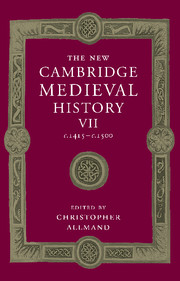Book contents
- Frontmatter
- PART I GOVERNMENT
- PART II ECONOMIC AND SOCIAL DEVELOPMENTS
- PART III SPIRITUAL, CULTURAL AND ARTISTIC LIFE
- PART IV THE DEVELOPMENT OF EUROPEAN STATES
- 17 Germany and the Empire
- 18 Hus, the Hussites and Bohemia
- 19 France
- (a) France at the End of the Hundred Years War (c. 1420–1461)
- (b) The Recovery of France, 1450– 1520
- 20 Burgundy
- 21 England
- 22 The Celtic world
- 23 Italy
- 24 The Iberian peninsula
- 25 The Swiss Confederation
- 26 The States of Scandinavia, c. 1390– c. 1536
- 27 Hungary: Crown and Estates
- 28 The Kingdom of Poland and the Grand Duchy of Lithuania, 1370–1506
- 29 Russia
- 30 Byzantium: The Roman Orthodox World, 1393–1492
- 31 The Latin East
- 32 The Ottoman World
- 33 Conclusion
- Appendix Genealogical Tables
- Primary Sources and Secondary Works Arranged by Chapter
- Index
- Frontispiece
- Plate section
- Map 1 European towns in the late Middle Ages
- Map 2 European commerce and trade
- Map 4 Winds and currents facilitating the discoveries
- Map 5 The universities o f Europe in 1400 and 1500
- Map 6 Germany and the Empire
- Map 20 The Roman Orthodox and Ottoman worlds in the fifteenth century
- References
(a) - France at the End of the Hundred Years War (c. 1420–1461)
from 19 - France
Published online by Cambridge University Press: 28 March 2008
- Frontmatter
- PART I GOVERNMENT
- PART II ECONOMIC AND SOCIAL DEVELOPMENTS
- PART III SPIRITUAL, CULTURAL AND ARTISTIC LIFE
- PART IV THE DEVELOPMENT OF EUROPEAN STATES
- 17 Germany and the Empire
- 18 Hus, the Hussites and Bohemia
- 19 France
- (a) France at the End of the Hundred Years War (c. 1420–1461)
- (b) The Recovery of France, 1450– 1520
- 20 Burgundy
- 21 England
- 22 The Celtic world
- 23 Italy
- 24 The Iberian peninsula
- 25 The Swiss Confederation
- 26 The States of Scandinavia, c. 1390– c. 1536
- 27 Hungary: Crown and Estates
- 28 The Kingdom of Poland and the Grand Duchy of Lithuania, 1370–1506
- 29 Russia
- 30 Byzantium: The Roman Orthodox World, 1393–1492
- 31 The Latin East
- 32 The Ottoman World
- 33 Conclusion
- Appendix Genealogical Tables
- Primary Sources and Secondary Works Arranged by Chapter
- Index
- Frontispiece
- Plate section
- Map 1 European towns in the late Middle Ages
- Map 2 European commerce and trade
- Map 4 Winds and currents facilitating the discoveries
- Map 5 The universities o f Europe in 1400 and 1500
- Map 6 Germany and the Empire
- Map 20 The Roman Orthodox and Ottoman worlds in the fifteenth century
- References
Summary
in 1521, Francis I of France visited Dijon, where he was shown the skull of John the Fearless, duke of Burgundy. The Carthusian monk who accompanied the king was alleged to have said ‘my lord, that’s the hole through which the English entered France’. He was referring to the wounds sustained by the duke from the axe-blows which felled him on the bridge at Montereau in September 1419. The shadow of that assassination fell over much of the succeeding period, which saw a profound crisis of Valois monarchy in the face of English invasion and French civil war. John the Fearless’s death was clearly a product of the internal strife which had plagued the higher echelons of French society since the murder of Louis of Orleans by his Burgundian enemies in 1407. Henry V’s successes were partly based upon his ability to exploit the internal divisions of the French nobility to his own ends. The Valois monarchy’s very survival was for a time thrown into question and it was not until the late 1430s and 1440s that positive signs of recovery were clearly visible.
Keywords
- Type
- Chapter
- Information
- The New Cambridge Medieval History , pp. 392 - 407Publisher: Cambridge University PressPrint publication year: 1998
References
- 1
- Cited by

